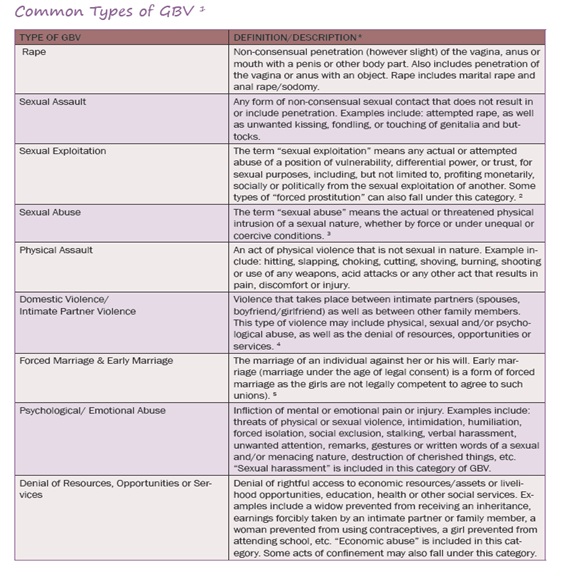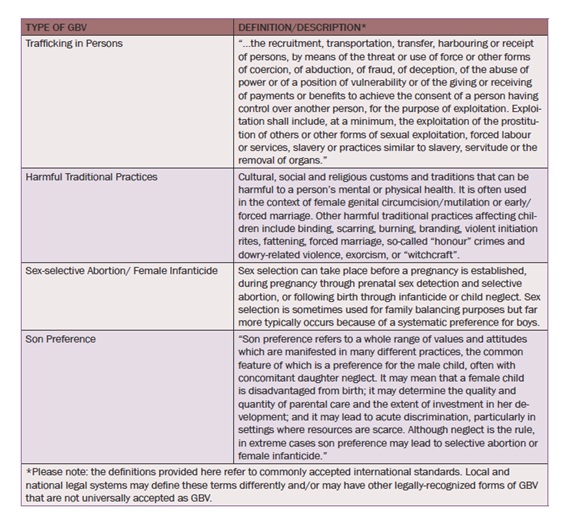- Different humanitarian actors have used different terminology in their VAWG-related policies, guidelines, and programming. Sometimes the range of this terminology and what various terms mean, and/or how they are interpreted by different actors, can be confusing. This module uses the language of VAWG, but many of the tools, resources, and programmes described in this module use other terminology. The following presents a brief breakdown of the most common terms used in humanitarian contexts that relate to the problem of violence against women and girls:
|
Sexual and Gender-based Violence (SGBV) |
The very earliest humanitarian programming addressing violence against conflict-affected women and girls focused on exposure to sexual violence and was primarily based in refugee settings. In 1996, the International Rescue Committee (IRC), in collaboration with UNHCR, introduced a project entitled the ‘Sexual and Gender-Based Violence Program’ in refugee camps in Tanzania. The inclusion of the term gender-based violence was reflective of the projects’ commitment to address types of violence other than sexual that were evident in the setting, particularly domestic violence and harmful traditional practices. Having been used in the Declaration on the Elimination of Violence against Women (DEVAW, 1993), where violence against women is described as “any act of gender-based violence”, GBV was an increasingly common ‘international’ term used to describe a spectrum of abuses to which women and girls are exposed as a result of discrimination against them in male-dominated cultures around the world.
Many of the original global guidelines and resources on addressing VAWG in conflict-affected settings use the language of SGBV. The SGBV phrasing continues to be officially endorsed and used by UNHCR, and their rationale for which is explained in their 2011 SGBV strategy document: “UNHCR consciously uses [SGBV] to emphasise the urgency of protection interventions that address the criminal character and disruptive consequences of sexual violence for victims/survivors and their families” (Action Against Sexual and Gender-based Violence: An Updated Strategy, UNHCR, 2011). |
|
Gender-based Violence (GBV) |
The Reproductive Health Response in Conflict (RHRC) Consortium began advocating in the early 2000s that humanitarian partners use the term ‘gender-based violence’ instead of SGBV, in order to clarify that sexual violence is a component of GBV rather than a separate issue. In 2005, the IASC officially adopted this language in the IASC Guidelines on Gender-based Violence Interventions in Humanitarian Settings. The IASC GBV Guidelines provide a definition of GBV that is the most commonly referenced in humanitarian settings: “Gender-based violence is an umbrella term for any harmful act that is perpetrated against a person’s will, and that is based on socially ascribed (gender) differences between males and females” (p. 7).
The IASC GBV Guidelines emphasize that women and girls are the ‘primary victims of GBV’ and the Guidelines themselves focus on strategies for addressing violence against women and girls. However, the IASC Guidelines acknowledge that men and boys may also be victims of gender-based violence, especially sexual violence. The IASC definition therefore reflects a broader conceptualization of the term than was originally articulated in the DEVAW; this shift from the DEVAW usage of GBV as synonymous with VAW to a slightly broader definition continues to stimulate discussions amongst GBV practitioners in humanitarian contexts about the scope of the term, as well as its usefulness when specifically referencing the problem of violence against women. In some instances people and organizations will use the term GBV to refer to violence against men and boys and/or violence against LGBTI populations. Some humanitarian actors use the language of VAWG in order to avoid any confusion associated with broader interpretations of GBV. They also may use the language of VAWG in order to avoid some of the challenges associated with translating the terminology of GBV in local contexts. |
|
Conflict-related Sexual Violence (CRSV) |
‘Conflict-related sexual violence refers to incidents or (for SCR 1960 listing purposes) patterns of sexual violence, that is rape, sexual slavery, forced prostitution, forced pregnancy, enforced sterilization, or any other form of sexual violence of comparable gravity, against women, men, girls or boys. Such incidents or patterns occur in conflict or post-conflict settings or other situations of concern (e.g., political strife). They also have a direct or indirect nexus with the conflict or political strife itself, i.e. a temporal, geographical and/or causal link. In addition to the international character of the suspected crimes (that can, depending on the circumstances, constitute war crimes, crimes against humanity, acts of torture or genocide), the link with conflict may be evident in the profile and motivations of the perpetrator(s), the profile of the victim(s), the climate of impunity/weakened State capacity, cross-border dimensions and/or the fact that it violates the terms of a ceasefire agreement’. (Analytical & Conceptual Framing of Conflict-Related Sexual Violence, 2011). Conflict-related sexual violence began to be used mainly by UN actors to encompass a broader range of sexual violence associated directly and indirectly with the conflict, rather than the more narrow and, perhaps, less precise “sexual violence in conflict.”
|
|
Sexual Exploitation and Abuse (SEA) |
“Sexual exploitation and abuse” is a phrase most often used to refer to abuses committed by humanitarian actors against beneficiary populations. Protection from sexual exploitation and abuse (PSEA) is another common term that speaks to humanitarian actors’ responsibilities to adopt codes of conduct and other measures to limit the extent of SEA in humanitarian operations. The UN Secretary-General’s Bulletin on protection from sexual exploitation and abuse (PSEA) (ST/SGB/2003/13) defines SEA and lays out some of the key elements of prevention. (For more information on SEA, see Section II on protection from sexual exploitation and abuse.) It is important to note that both sexual exploitation and sexual abuse can be committed by non-humanitarian workers, and that the umbrella term of GBV often includes reference to these forms of sexual exploitation and/or sexual abuse. In general, a basic rule in determining if the language of sexual exploitation and/or sexual abuse is referring to abuses by humanitarian actors is whether or not the single phrase of ‘SEA’ is being employed. |
- While the umbrella terms described above can be useful in describing an overall phenomenon of violence, it is important when designing and implementing programming and policies to recognize and address discrete forms of violence in order to target efforts more effectively. It is also critical in data collection and analysis to be clear about specific types of violence being reported. To this end, the GBV Information Management Systems Project has developed an incident classification system. (The GBV information management system (GBVIMS) is described further in Section VII under Data Collection within and across Response Programming.) UNFPA also offers the following matrix of definitions in their Curriculum Guide for Managing Gender-based Violence Programmes in Humanitarian Settings, which build on the GBVIMS:


